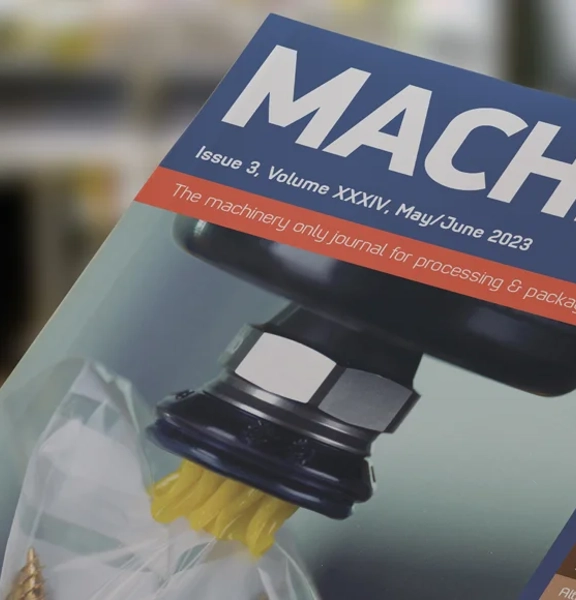Become a member
Take advantage of exclusive member benefits, world class events, networking and specialist support








 Become a member
Become a member 

10 October 2024
Several misplaced concerns are forming barriers to investment, says a Domino director, from the sense that automation is unnecessary or else irrelevant to fears of greater complexity.
Despite widespread acceptance of manufacturing automation, some businesses are lagging behind, Adem Kulauzovic confirms. A 2023 report by the Manufacturing Technology Centre revealed that UK manufacturers’ reluctance to invest in automation and robotics has notably impacted the country’s recent productivity gains, the director of automation adds.
“Domino Printing Sciences has uncovered seven critical – and misplaced – concerns around adopting factory automation,” he says. “If you're still holding back on your automation journey, the time to move is now.”
· Myth 1. Automation is unnecessary
“Let’s address the main elephant in the room,” Kulauzovic continues. “Outdated manual processes, including manual data entry, are a massive cause of errors, unnecessary waste, and cost.”
The average error rate in manual data entry is about 1%, the company estimates. If workers on a production line are manually entering data, it will not take long before a data entry error is applied to a product, he claims. There is then a good chance that this error will only be spotted after it has caused a significant amount of waste. Once a labelling error enters the supply chain, the cost and waste involved are even more significant.
· Myth 2. Automation doesn’t apply to me
A common argument against automation is that the unpredictability experienced by some businesses such as contract packers makes implementation impossible. In reality, says Kulauzovic, the opposite is true.
“Simple automated solutions can replace the need for manual data entry,” he explains. “A barcode scanner can populate product labels automatically based on existing production orders, or printers can be set up to populate label templates from a central database.”
In a facility with multiple production lines, coding automation software will allow staff to network printers together and automatically populate label data from a central location, like a production office, SCADA or ERP system. This can be combined with machine vision for real-time quality control.
· Myth 3. Automation replaces people
It is true that specific tasks – for example, code creation and data entry – are more suited to automation than manual workers. However, these are often menial, entry-level roles that are increasingly difficult to fill.
The manufacturing industry is suffering from a labour shortage. A recent report from Deloitte suggests that US manufacturing alone may need as many as 3.8 million new roles by 2033, with potentially 1.9 million going unfilled.
The true role of robotics and automation in manufacturing is not to replace but to complement operator involvement.
· Myth 4. Automation is not for SMEs
“It’s a common misconception that automation is only accessible to large organisations with access to capital and skills,” Kulauzovic states. “This is simply untrue. SMEs can automate routine, low-skilled tasks such as manual data entry to use their limited workforce more effectively.”
Moreover, he adds that for small companies, the consequences of failure are significantly higher than for larger corporations, and the much-quoted $10 million cost of a product recall is likely to spell financial ruin.
· Myth 5. Automation is too expensive
Here, Domino quotes Machinery Update publisher Automate UK’s Industry Insights Survey 2024, and its finding that cost is seen as being the most significant barrier to the adoption of automation.
In fact, Kulauzovic suggests this is an outdated concern, quoting EY as saying that the average price of an industrial robot has halved over the past decade and is expected to continue dropping. Moreover, he adds, those investing in automation can expect to save money on operational expenditure. But if cost remains a concern, many providers will now offer opex rather than capex models, with flexible finance plans and contracts making adoption more affordable.
· Myth 6. Automation is complicated
“Automation is not an ‘all or nothing’ commitment,” says Kulauzovic. “Businesses can start small by identifying a single area where automation could overcome specific production issues or enhance a single point in the production cycle.”
For many businesses, a quick win is streamlining product changeovers. For example, an automated monitoring solution can be implemented to provide a real-time product count and corresponding alerts to inform production staff when a production run is ending, allowing them to prepare ahead of time. This is a simple change, but the reduction in changeover time is proven to unlock capacity for extra production runs – daily.
· Myth 7. Automation requires extra skills
A final common misconception about automation is the idea that in-house skills are needed to manage any transition. Many automation providers will offer services to handle retrofits and implementation – and, once implemented, automated systems commonly demand fewer in-house skills to keep running efficiently.
Persistent myths about adopting automation linger, Domino concludes. But, given financial benefits, increasing availability, and the growing willingness of automation partners to help finance and implement new solutions, the real question is: can you afford not to adopt factory automation?
01954 782551